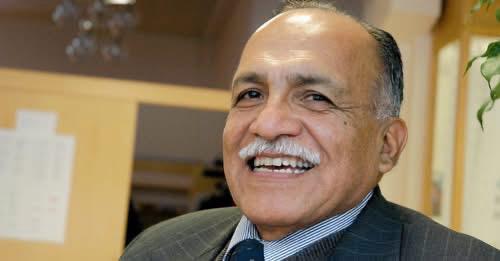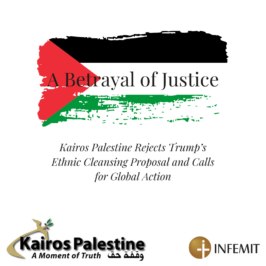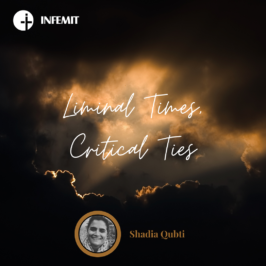by Beni Mocan
Presented for the Stott-Bediako Forum
Beni Mocan is a doctoral student at the ”Aurel Vlaicu” University of Arad, Romania. His area of study is Public Theology, and he especially focuses on the contributions of Pentecostal spirituality to building a public theology for the authentic progress of contemporary society.
Beni prepared this paper as part of INFEMIT’s Stott-Bediako Forum, to explore the aspects of Pentecostal spirituality that contribute to Peace Building and Conflict Transformation in Post-Dictatorial Romania.
Continue to read the full paper below.

“Not by Might, Nor by Power”: a Spirit-filled Imaginary towards Peace Building in Post-Dictatorial Romania
Postcolonial and postcommunist cultures are recently considered to be siblings of subalternity, highlighting many similarities as traumatized post-imperialist cultures. One of the main features of an imperialist, dominant culture consists in its continuous strive to define the development of national and group identity. When referring to the Romanian communist past, the persecution of the Pentecostal church constituted the central way by which the communist authorities tried to influence the formation of the Romanian face of Pentecostal identity.
Whenever one speaks of conflict, she speaks of the involvement of (at least) two parts; of an exchange that happens in their interaction; of their identities and perceptions of the other; of the action each part takes over against the other; of the formation of both alterity and identity. Hence, in what follows, we want to uncover what kind of alterity is hidden within the discourse of the Romanian Pentecostal Church in the past communist times. To accomplish this task, we looked at the magazine of the Romanian Pentecostal Church, The Word of Truth, which was published between 1953-1989 as The Magazine of the Romanian Pentecostal Church (MRPC).
God, Ourselves and the Others
The beginnings of the Romanian Pentecostal Church were extremely difficult, as the historian Valeriu Andreiescu remarks: “The political crisis from 1931 to 1940, which would involve Romania in World War II, provided an unstable framework for the development of Pentecostalism, gradually pushing it into the deepest catacombs. The failure of institutionalization recognized or at least tolerated by the state led spontaneously to the decentralization of the movement” (Andreiescu, 2012, 165-166).
At the socio-political level, the years 1953-1989, which we have in mind, are under the shadow of the two world wars and the desperate attempts, of all the nations of the earth, to avoid the outbreak of another war. This reality decisively influenced the Pentecostal imagination of otherness, as we will see below. An overview of the imagination of otherness, as it appears in the MRPC, from the period of time we are considering, will reveal that the main otherness drawn is that of “society” – whether it is described as “homeland” or as “the peoples / nations of the world”. One might argue that a reduced otherness to a single subject cannot promise much but let us not neglect the fact that this allows us a much more detailed analysis of it.
The first issue of the MRPC highlights the coordinates on which the imagination of otherness will move. The greatest blessing given to the world by God is the peace he gave through the Lord of peace, Jesus Christ. He is in opposition to Satan, “who from the beginning was a murderer, manifesting his hatred of life and peace” (MRPC I (1), September 1953: 15). Like this polarization, people are also divided into two categories: (1) nominal Christians, “who boast of Christianity but are far from the teachings of the One who came to bring and live peace” and (2) the children of God who “pursue the things that lead to peace” (Ibid.: 16).
Having two lords and two categories of people, the imagination of the conflict or struggle between them should be extremely well outlined. However, the struggle between Jesus and Satan and the (possible) battle between nominal Christians and God’s children is not emphasized at all. Rather, the imagination of otherness, i.e., those outside of the community of faith, is kept within normal limits, with no radical accents of any kind – so we cannot speak of its polarization. The emphasis of otherness is therefore not on “others”, but on “us”, highlighting the responsibility of God’s children for peace:
If today, when peace is threatened, we will not fight for its victory, but we will remain cold and indifferent to everything that happens around us, it means that we do not listen to the voice of the One who commands us to seek peace; it means that we have deserted the duty he has given us to be peacemakers, and in this way we cannot count ourselves among the true believers, but rather among the traitors of the cause of God’s work, who sends water to the mill to the one who was a “killer” from the beginning. Let us not imagine that if we do not enlist in the front of peace, we will be able to remain neutral, because according to the Gospel of Christ, there are no neutrals among His believers. […] Whoever is not at the forefront of peace is against it and is in the camp of those who want war (Ibid., 16).
Therefore, “the man driven by the power of love […] goes to work and sacrifices […] for society” (MRPC VI (2), February 1958: 8). He is consumed by this duty because he is “the new man”, a “loving man”, “a true disciple of the Savior”, his main virtue being the sincere love of people, a love ”that does not ask about one’s language, nationality, social condition or calling, dignity or rank” (MRPC X (5-6), May-June 1962: 6). The tightness of this duty he feels translates into his prayer that “God will abundantly pour out his peace upon our dear country R.P.R. […] And give it to the whole world”, because all people are created in His image and have the right to work in peace and security (MRPC III (3), March 1955: 2). The foundation of this spirituality of peace is found in a specific biblical-poetical imagination. In the following we will try to draw this imaginary as faithfully as possible.
The Biblical-Poetical Imagination of Love and Peace
The Pentecostal biblical imaginary as a source of the spirituality of love and peace has as its inspiration three main biblical images: (1) the act of creation, (2) Jesus as the prototype of love and peace, and (3) the dove as a symbol for the Spirit of peace.
Regarding the image of creation, two main aspects are highlighted that underlie the formulation of the longing and work for peace: the perfect order of creation and the unity of creation. God is the God of order, not of chaos, and therefore “does not like tangled, mixed, and unruly things,” so He brought the earth “out of its chaos” by separating light from darkness, the waters above from down, etc. At the same time, there is an order of how the whole creation works. The principle of order, therefore, is closely connected with the principle of peace, because “where good order reigns, peace reigns, and where peace reigns, the presence of the Saviour Christ is evident” (MRPC VI (3), March 1958: 1). Consequently, the true Christian is obliged to live in order and peace “both in the church and in every place in society” because he is “a son of peace who [must] live in peace with all men [cf. Rom. 12:18]”. Only in this way can “progress be made and all men may live together on earth in good order and in peace, as is the will of God” (Ibidem).
Beyond the order of creation, we can also talk about its unity. The creation is “a unitary work from which nothing is missing, and anything snatched leaves a felt void” (MRPC VI (7), July 1956, 3). This unity of creation speaks of the existence of a single Creator, “master and ruler of all existence” and of the existence of “a single source of life; of God” (Ibid.: 3). The unity of creation, divided by sin, can be restored only through the unity of Christianity, of the body of Christ called to embody the “mystery of the imitation of God,” of the consuming love of neighbour [and] of every being that bears the image of God, which is an embrace of the whole world” (Ibid.: 6). Jesus as the “Lord of love” and the “prototype of the loving man” is one of the fundamental images that underlies the relationships with the others. The image of a Jesus who “condemned war and loved peace” appears recurrently during this period of the existence of the Romanian Pentecostal Church (MRPC VI (2-3), February-March 1956: 17-18). This image is coupled in the Pentecostal imaginary with that of the Holy Spirit as the Spirit of love and peace. The spirit is the spirit of love and peace, the two virtues being closely linked to each other. The Holy Spirit is the Spirit of Jesus, who in the Pentecostal imaginary refers primarily to the symbol of the dove of peace that descended upon Jesus at his baptism in the Jordan River (Mark 1:10). The person of Jesus “is sincere, full of love and consolation, full of innocence and beauty”, virtues that come in antithesis to the society of that time, which was “full of cunning, hypocrisy, mistrust and harshness” (MRPC XXXII (5-6), May-June 1984: 6-7). Therefore, the Holy Spirit, being the Spirit of Jesus, it is the Spirit of peace: “With this Spirit Jesus still makes His call resound today […]. And this Spirit that revives, that puts things in order and that builds the soul is needed in our human society” (Ibid.: 7).
A Peaceful Gospel for Transforming the World
Linking the three images from above, i.e., the goodness of creation, Jesus as a prototype of love and peace, and the dove as a symbol for the Spirit of peace, to the reality of post-colonialism and post-communism, we consider Yoder’s understanding of pacifism as extremely helpful. Somewhat paradoxically, Yoder’s pacifism springs from the actual war between the cross and the Powers (Yoder, 1994: 143). Yoder’s “eschatological battle” is actually founded on what he calls “Paul’s exousiology” (Ibid.: 144). For him, this exousiology represents a very good analysis of the problems of society, ‘far more refined than the other ways in which theologians have sought to describe the same realities in terms only of “creation” or “personality”’ (Ibid.: 143). Since the Powers are created by God we cannot live without them, but since they are fallen we cannot live with them. The Christians existence is therefore an existence in-between this two-sided nature of the Powers. Living in this tension, Christians have a twofold mandate: (1) to expect the full redemption of God, and (2) to work out this redemption in partnership with God. Jesus already destroyed the sovereignty of the Powers by ‘living a genuinely free and human existence’, and through his crucifixion he crushed the power of the Powers (Ibid.: p. 145). This reality is a social, political, public fact. Yoder resists any metaphysical interpretation of the meaning of the Powers, or any personalistic reductionism of their meaning. This is why he speaks of “a whole new order”, of “an alternative to the present order”, of “a renewed way of living in the present”, of “the co-existence of the old and new orders”, or of “a new humanity” (Ibid.: 185-219).
One of the most important feature of the Romanian Pentecostalism’s protest was prayer, or lament. Since inter-religious dialogue was impossible under communism, for religion was considered of no real use for the progress of society, the Pentecostal church quickly learned to express both its trust in the intervention of God within society and its critical assessment of the world by assiduous and never-ending prayer. Surely, over the years, the more the communist authorities intensified their persecution of the church, the more the lamentations of believers intensified. In our view, this historical reality generated inevitably an essential and unique feature of the Spirit-filled imaginary we address here: a peaceful gospel. While Romanian Pentecostalism was even from the start a paramodern movement (cf. Archer, 2009: 5), having a strong character of protest, the decades of political oppression moulded in its spirituality a specific humble and peaceful approach to society, and the world in general. This can easily be seen in almost all, if not all, of the public engagements of the Romanian society – e.g., the peaceful rallies in support of a Romanian Pentecostal family from Norway whose five children were abusively confiscated by the Norwegian state (see www.bodnariufamily.org), or the national referendum on the redefinition of marriage within the Romanian Constitution from 6 to 7 October 2018, with all the debates and inter-religious dialogues surrounding this event. Surely, this reality has its downsides, especially when we speak of the long and heavy process of social engagement of Romanian society after the fall of communism – a process that is still at its utmost beginnings. But nonetheless, the richness of the humble character of protest are far more greater. Due to its tumultuous past, the Romanian Pentecostal Church knows evil and its manifestations from within; she felt it on its skin; she shaw the mechanisms of oppression in all their ugliness; and so, she tearfully prayed: for God’s intervention, for a better world, for peace.
…the more the communist authorities intensified their persecution of the church, the more the lamentations of believers intensified. In our view, this historical reality generated inevitably an essential and unique feature of the Spirit-filled imaginary we address here: a peaceful gospel.
Beni Mocan
And God intervened. He brought peace. Since 1989, Romania finds itself on the road towards a democratic society. It sill has a long way to come there, but nonetheless significant steps have already been made. In this new world, there is plenty of room for dialogue for peace building. The fall of communism brought with it a resurgence of religion. Generally speaking, all the Romanian churches reported increase of demographics, especially between 1990 and 2000. Hence, the need for inter-religious dialogue is great.
Moreover, after the end of communism, Romania also entered a period of transition towards a democratic society, a transition which is still very much existent. The communist heritage mentioned above coupled with the general disillusionment that results out of this ongoing transition functions as a strong barrier against the contribution the Romanian Pentecostal Church has the potential to bring. Romanian Pentecostal spirituality has nonetheless an immense richness hidden within it, that can and will become visible in the near future for the betterment of the Romanian society.
Bibliographical sources
Andreiescu, Valeriu, Istoria penticostalismului românesc Volumul 1: Evanghelia deplină și puterea lui Dumnezeu (Oradea: Casa Cărții, 2012).
Archer, Kenneth, A Pentecostal Hermeneutic: Spirit, Scripture, and Community (Cleveland: CPT Press, 2009).
Bochian, Pavel, ”Good order and peace” in The Magazine of the Pentecostal Church VI (3), March 1958: 1.
Bradin, Gheorghe, ”Pray for peace” in The Magazine of the Pentecostal Church III (3), March 1955: 2.
Bradin, Gheorghe ”Seek peace and run after it” in The Magazine of the Pentecostal Church I (1), September 1953: 15.
I.D., ”Creation and new creation” in The Magazine of the Pentecostal Church X (5-6), May-June 1962: 6-7.
Marin, Blaje, ”The Origin of Love” in The Magazine of the Pentecostal Church VI (2-3), February-March 1956: 17-18.
Publisher, ”God is Love” in The Magazine of the Pentecostal Church VI (2), February 1958: 8.
Publisher, ”The Symbols of the Holy Spirit” in The Magazine of the Pentecostal Church XXXII (5-6), May-June 1984: 6-7.
V.I., ”The Image of a Christian” in The Magazine of the Pentecostal Church VI (7), July 1956: 3-8.
Yoder, H. John, The Politics of Jesus: Vincit Agnus Noster, second edition (Grand Rapids: Eerdmans, 1994)
The views and opinions expressed in this piece are those of the author and do not necessarily reflect an official position of INFEMIT. We seek to foster reflection through conversation, and ask you to be respectful and constructive in your comments.






Leave a Reply